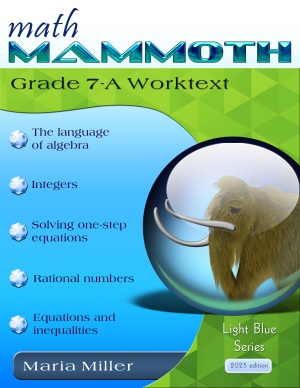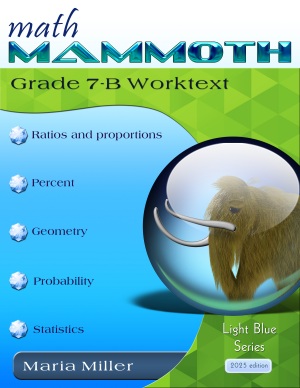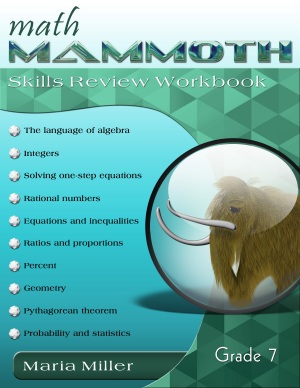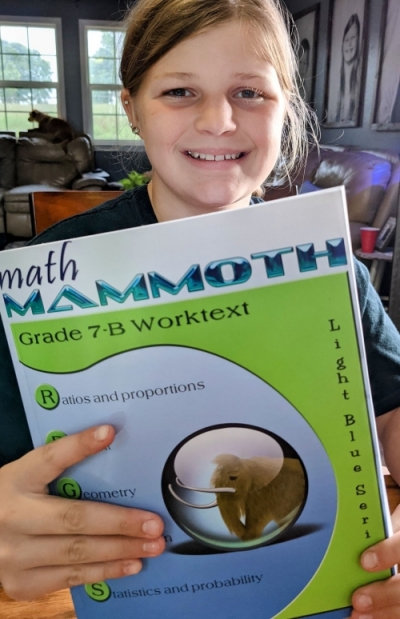Math Mammoth Grade 7 curriculum
Math Mammoth Grade 7 Curriculum is a complete math program for 7th grade, covering typical pre-algebra topics. After it, many students can go on to an algebra 1 program. Those who benefit from a slower pace with algebra concepts can go to Math Mammoth Grade 8.

224 pages
197 lesson pages

268 pages
244 lesson pages
2025 edition:
7-A contents and samples
7-B contents and samples
User Guide (2025 edition)
CCS Documentation
Errata (2025 edition)
2014 edition:
7-A contents & samples
7-B contents & samples
User Guide (2014 edition)
CCS Documentation
Errata (2014 edition)
Worksheet generator preview
FAQ: Edition changes
Scope & sequence (grades 1-8)
FAQ
Prices & ordering
You can purchase Math Mammoth Grade 7 as a digital download or as already printed books.
Digital version
2025 edition
Grade 7 complete:
USD $42.50 (download)
(the two worktexts, answer keys, tests, cumulative reviews, a worksheet maker, Soft-Pak)
Part 7-A only:
USD $21.25 (download)
(Everything for the first half of 7th grade math; includes Soft-Pak)
Part 7-B only:
USD $21.25 (download)
(Everything for the second half of 7th grade math; includes Soft-Pak)
2014 edition
Grade 7 complete:
USD $42.50 (download)
(the two worktexts, answer keys, tests, cumulative reviews, a worksheet maker, Soft-Pak)
Part 7-A only:
USD $21.25 (download)
(Everything for the first half of 7th grade math; includes Soft-Pak)
Part 7-B only:
USD $21.25 (download)
(Everything for the second half of 7th grade math; includes Soft-Pak)
You will be purchasing the downloads from my authorized reseller Comecero.
Printed copies
See full details about the printed copies on this page.
Rainbow Resource Center sells perfect-bound texts either with full color or with grayscale interior pages:
MM grade 7 (b&w) 2014 ed.
MM grade 7 (color) 2014 ed.
Lulu sells spiral (coil) bound versions of the student books and of the tests & reviews book.
2025 editions:
7-A worktext
7-B worktext
Tests & Cumulative Reviews
Answer Keys (perfect bound)
2014 editions:
7-A worktext
7-B worktext
Tests & Cumulative Reviews
Answer Keys (perfect bound)
We also provide a list of ISBN numbers so you can order at Amazon or other bookstores.
Supportive materials
Includes the answer keys, tests, cumulative reviews, worksheet maker, and software Soft-Pak (digital download). Purchase this to go with printed student books. Do not purchase if you get the full digital version as listed above.
2025 edition (USD $9.60):
2014 edition (USD $9.60):
Lesson plan
You can purchase a lesson plan for Math Mammoth Grade 7. It can be used in Homeschool Planet online planner or without it. Learn more.
Skills Review Workbook

The Grade 7 Skills Review Workbook provides additional practice for the topics in the curriculum, in a spiral manner. I recommend you only purchase it once you are sure the student does need supplemental practice. Learn more.
At the heart of the curriculum are two student worktexts (A and B), each covering about half a year of math work. These worktexts contain all the instruction and the exercises in the same book — which makes lesson preparation a breeze. The worktexts are written directly to the student, and thus they allow many students to teach themselves and to learn directly from the books.
You will also get separate answer keys, chapter tests, additional cumulative reviews (I do recommend you use at least some of them), and a versatile worksheet maker (Internet access required) for those times when your child needs just a bit more practice.
Features
- Math Mammoth focuses on conceptual understanding. It explains the "WHY", so your children can understand the math, not just learn "HOW" to do it.
- Concepts are often explained with visual models, followed by exercises using those models. These visual models can take the place of manipulatives for many children; however, it is very easy to add corresponding manipulatives to the lessons if so desired.
- The curriculum is mastery-oriented. This means it concentrates fairly long on a topic, delving into its various aspects. This promotes conceptual understanding, as opposed to spiral curricula that often tend to jump from topic to topic too much.
- It requires very little teacher preparation.

- The curriculum has no separate teacher's manual nor is it scripted. The introduction to each chapter has some notes for the teacher concerning the material in the chapter. All the instruction is written directly to the student in the worktext, and there also exist accompanying videos where you can see Maria herself teach the material.
- After each chapter introduction, you will find a list of Internet links and resources (games, quizzes, animations, etc.) that can be used for fun, illustrations, and further practice.
Please read the FAQ for more information.
Additional features for the digital version (download)
- The PDF files can be filled in on a computer, phone, or tablet, using the annotation tools found in many PDF apps. Learn more.
- BONUS! The digital version comes with BONUS Soft-Pak programs. The 6 programs in Soft-Pak (4 math, 1 language arts, 1 list maker) offer both on-screen and printable activities in a low-graphic, high content format. Read more and see screenshots.
Overview of topics
The main areas of study in Math Mammoth Grade 7 are:
- introduction to basic algebra concepts
- integers and their operations
- solving one-step equations, including with negative numbers
- rational numbers, focusing on calculations that involve negative decimals and negative fractions
- solving linear equations and inequalities (special cases), and writing equations and inequalities for word problems
- ratios, rates, proportions, and percent
- geometry: angle relationships, drawing figures with given conditions (including compass & ruler constructions), Pi and the area and circumference of a circle, cross-sections formed when cutting solids, surface area, and volume
- probability
- statistics: random sampling and comparing two samples/populations
Please also see the table of contents 7-A and 7-B (in the sample files), which will let you see the topics covered in more detail.
Manipulatives
Here is a list of measurement tools that are needed for grade 7-B.
- A ruler that measures in inches (for 7-B).
- A ruler that measures in centimeters (for 7-B).
- A compass (for 7-B).
- A protractor (for 7-B).
Supplements
Lesson plan
We offer a lesson plan for Math Mammoth Grade 7 for the Homeschool Planet online planner. This is available in two versions: regular, and PLUS plan which also includes a PDF file of the plan. Learn more.
Skills Review Workbook
Math Mammoth Skills Review Workbook, Grade 7 provides additional practice for the topics in Math Mammoth Grade 7 curriculum. I recommend you only purchase it once you are sure the student does need supplemental practice. Learn more.
Introduction
Math Mammoth Grade 7-A and Grade 7-B worktexts comprise a complete math curriculum for seventh grade mathematics studies. This is a pre-algebra course, and students can continue to an algebra 1 curriculum after studying it. The curriculum meets the Common Core Standards for grade 7.
We start out with an introduction to basic algebra, which is in many ways a review of the same topics from 6th grade. The first chapter reviews the order of operations, the concepts of an expression and equation, and the distributive property. Students learn about the commutative and associative properties of addition and multiplication, and they simplify expressions that don’t involve negative numbers.
In chapter 2, we study integers and their operations in detail. Some of this is, again, review from 6th grade, and some of it is new. The four operations of integers are explained with the help of two visual models: the number line and counters, hopefully providing an intuitive understanding of the processes. Students need to be able to add, subtract, multiply, and divide integers when they learn to solve equations in chapter 3. In the end of the chapter students also learn about negative fractions.
In the next chapter (chapter 3) students study simple one-step equations. They already know the basics of how to solve these types of equations from 6th grade, but this time we use negative numbers in them.
Chapter 4 is titled Rational Numbers, which are simply fractions and certain decimals, so the student is already very familiar with them. The goal of the chapter is to be able to add, subtract, multiply, and divide both positive and negative fractions and decimals and also do more complex calculations with them. We also solve simple equations involving fractions and decimals and learn about complex fractions.
The last chapter in part 7-A focuses on linear equations. The student learns to solve various types of linear equations and practices writing such for simple word problems. We also study linear inequalities, but not to the same depth as linear equations.
Part B starts out with a study of ratios and proportions (chapter 6). Students study unit rates, proportions, proportional relationships, scale drawings, and floor plans.
The next chapter provides thorough lessons on the concept of percent. Students learn to solve a wide variety of problems involving percentages, including percentage of change and simple interest problems.
Geometry is our focus in chapter 8. Students draw geometric figures with given conditions (e.g. a triangle with 60° and 50° angles and a 6-cm side), and they also learn some basic geometric constructions. The other themes of this chapter are various angle relationships, area and the perimeter of a circle, conversions between units of area and of volume, surface area, volume, and cross-sections when solids are sliced with a plane.
Chapter 9 is an introduction to probability. Besides learning the basic idea behind probability as the ratio of favorable events to all possible events, students compare experimental probabilities to theoretical ones in probability simulations and even design some on their own.
Lastly, in chapter 10, the curriculum covers statistical concepts. The major areas of study are random sampling and learning to compare two populations using some basic statistical measures and graphs.
Please read the FAQ for more information.
Reviews / Testimonials of the 7th grade curriculum
Math Mammoth · Affordable Homeschool Curriculum for 7th Grade at Grace, Grow & Edify blog
Math Mammoth Light Blue Series Level 7: A TOS Review Crew Review at Grace-Filled Homeschooling blog
Review of Math Mammoth Prealgebra Curriculum by David Chandler from Math Without Borders.
Well, last year was a serious challenge. We did get through the program, but it wasn't much fun. I was about to make another serious error and plow on to Algebra 1, but in my heart I just knew my son hadn't mastered pre-algebra, and his math-confidence was badly shaken. He's always loved math so this was a real heartbreak for me. I finally did something right and ordered Math Mammoth pre-algebra. I needed to make this right! I am writing to tell you that my son's confidence is being restored with every lesson, and I can see that he is starting to love math again. Making this change has positively impacted our entire school experience. I can't thank you enough.
With all my gratitude,
Deirdre
I just covered 7th grade the distributive property.
YES!!!! I love the way you introduced this and the way the problems build to understanding. My students were excited about solving these problems. It was like a fun puzzle for them. This is a big gem!!!!
Beautiful.
deb b. :)
Tara Dilan
How and where to order
You can buy Math Mammoth books at:
- Here at MathMammoth.com website — simply use the "Add to cart" buttons you see on the product pages.
- Rainbow Resource carries printed copies for the Light Blue series books, plus several CDs (Light Blue and Blue series).
- Homeschool Buyers Club offers download versions of the Light Blue series, plus the Blue series bundle.
- Homeschool Planet sells the digital versions of the main curriculum and lesson plans to go with them.
- K5 Learning offers download versions of the Blue series.
- TPT sells the Light Blue Series downloads, plus topical units.
- Lulu sells printed copies for most of the Math Mammoth materials (various series).
By purchasing any of the books, permission IS granted for the teacher (or parent) to reproduce this material to be used with his/her students in a teaching situation; not for commercial resale. However, you are not permitted to share the material with another teacher.
In other words, you are permitted to make copies for the students/children you are teaching, but not for other teachers' usage.
Math Mammoth books are PDF files. I recommend you use Adobe Reader to view them, including if you use a Mac. You can try other PDF viewers, but they may at times either omit or mess up some of the images.
Receive my monthly collection of math tips & resources directly in your inbox — and get a FREE Math Mammoth book!
You can unsubscribe at any time.
Math Mammoth TourConfused about the different options? Take a virtual email tour around Math Mammoth! You'll receive: An initial email to download your GIFT of over 400 free worksheets and sample pages from my books. Six other "TOURSTOP" emails that explain the important things and commonly asked questions concerning Math Mammoth curriculum. (Find out the differences between all these different-colored series!)This way, you'll have time to digest the information over one or two weeks, plus an opportunity to ask me personally about the curriculum. A monthly collection of math teaching tips & Math Mammoth updates (unsubscribe any time) We respect your email privacy.
Note: You will FIRST get an email that asks you to confirm your email address. If you cannot find this confirmation email, please check your SPAM/JUNK folder. |
"Mini" Math Teaching CourseThis is a little "virtual" 2-week course, where you will receive emails on important topics on teaching math, including:
- How to help a student who is behind You will also receive: A GIFT of over 400 free worksheets and sample pages from my books right in the very beginning.We respect your email privacy.
Note: You will FIRST get an email that asks you to confirm your email address. If you cannot find this confirmation email, please check your SPAM/JUNK folder. |
Maria's Math TipsEnter your email to receive math teaching tips, resources, Math Mammoth news & sales, humor, and more! I tend to send out these tips about once monthly, near the beginning of the month, but occasionally you may hear from me twice per month (and sometimes less often). Peek at the previous tips here. You will also receive:
We respect your email privacy.
|
|

